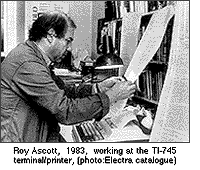 In early 1983, Roy Ascott was invited to propose a work for the exhibition "ELECTRA 1983" - a survey of the use of electricity in art - organised by Frank Popper for the Musée d'Art Moderne de la Ville Paris. Ascott's proposal was to use the ARTEX network both as an organising instrument and as a textual medium for the creation of a world-wide, distributed narrative - a collective global fairy tale. In early 1983, Roy Ascott was invited to propose a work for the exhibition "ELECTRA 1983" - a survey of the use of electricity in art - organised by Frank Popper for the Musée d'Art Moderne de la Ville Paris. Ascott's proposal was to use the ARTEX network both as an organising instrument and as a textual medium for the creation of a world-wide, distributed narrative - a collective global fairy tale.
On July 13 he posted a description of the project and call for participation on ARTEX and artists and groups in 11 cities in Europe, North America and Australia agreed to join the project. In November each participant was allocated the role of traditional fairy tale character: princess, witch, fairy godmother, prince etc.. (see message below)
Beyond the simple idea of a fairy tale, Ascott did not suggest a story line or plot - the artists were simply asked to improvise. The result was that, due to the differences between time zones and the nature of improvisation, the narrative often overlapped and fragmented in the manner of the surrealist game of "Exquisite Corpse".
La Plissure du Texte was active on line 24 hours a day for 12 days - from December 11 to 23, 1983 and, although every location should have an identical copy of the complete text, for some unknown reason all versions are somehow different - there is no final or definitive version of the text. There is a version on line (rather fragmented and incomplete) that was captured on disc in Toronto by Norman White: <www.normill.ca/Text/plissure.txt> (371 k).
La Plissure du Texte was conceived and coordinated by Roy Ascott, network organisation was by Robert Adrian, coordinators at the various locations were: Bruce Breland (Pittsburg); Hank Bull (Vancouver); David Garcia/Annie Wright (Amsterdam); Eric Gidney (Sydney); Helmut Mark/Zelko Wiener (Vienna); Greg McKenna/Tom Klinkowstein (San Francisco); John Southworth (Honolulu); Norman White (Toronto).
PHOTOGRAPHS
|